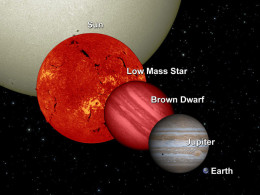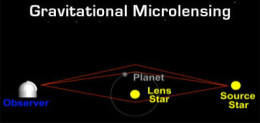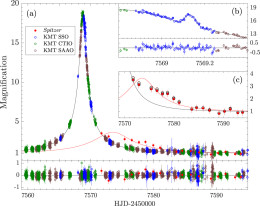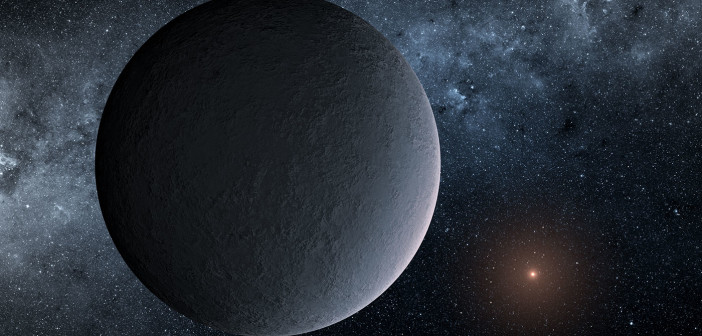What do we know about planet formation around stars that are so light that they can’t fuse hydrogen in their cores? The new discovery of an Earth-mass planet — orbiting what is likely a brown dwarf — may help us better understand this process.
Planets Around Brown Dwarfs?

Comparison of the sizes of the Sun, a low-mass star, a brown dwarf, Jupiter, and Earth. [NASA/JPL-Caltech/UCB]
To answer this question, scientists have searched for planets around brown dwarfs with marginal success. Thus far, only four such planets have been found — and these systems may not be typical, since they were discovered via direct imaging. To build a more representative sample, we’d like to discover exoplanets around brown dwarfs via a method that doesn’t rely on imaging the faint light of the system.

A diagram of how planets are detected via gravitational microlensing. The detectable planet is in orbit around the foreground lens star. [NASA]
Lensed Light as a Giveaway
Conveniently, such a method exists — and it’s recently been used to make a major discovery! The planet OGLE-2016-BLG-1195Lb was detected as a result of a gravitational microlensing event that was observed both from the ground and from space.
The discovery of a planet via microlensing occurs when the light of a distant source star is magnified by a passing foreground star hosting a planet. The light curve of the source shows a distinctive magnification signature as a result of the gravitational lensing from the foreground star, and the gravitational field of the lensing star’s planet can add its own detectable blip to the curve.
OGLE-2016-BLG-1195Lb

The magnification curve of OGLE-2016-BLG-1195. The peak in the curve in (a) shows the main microlensing by the lens star. An additional blip just after the peak, shown in detail in inset (b), shows the additional lensing by the planet. [Shvartzvald et al. 2017]
The team’s models indicate that the host is a ~0.072 solar-mass (~74 Jupiter-mass) star, which — if it has the same metallicity as the Sun — likely lies just below the hydrogen-burning mass limit. A ~1.3 Earth-mass planet is orbiting it at a projected separation of ~1.11 AU. The system lies in the galactic disk, roughly 13,700 light-years away.
Looking to the Future
This discovery confirms that the protoplanetary disks of ultracool dwarfs do, in fact, contain enough mass to form terrestrial planets. In addition, the find represents a remarkable technical achievement. OGLE-2016-BLG-1195Lb is the lowest-mass planet ever detected using gravitational microlensing, which bodes well for continued and future microlensing campaigns with high cadences and high detection sensitivity. With luck we’ll soon be able to expand our sample of planets discovered around these unusual hosts, allowing us to build statistics and better understand how and where these planets form.
Citation
Y. Shvartzvald et al 2017 ApJL 840 L3. doi:10.3847/2041-8213/aa6d09


1 Comment
Pingback: Ανακαλύφθηκε ένας εξωπλανήτης «δίδυμος» της Γης - Ecozen